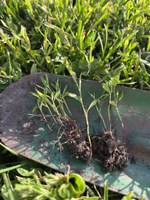Dakota Gardener: In knots about prostrate knotweed
(Click an image below to view a high-resolution image that can be downloaded)
By Carrie Knutson, Horticulture agent
NDSU Extension – Grand Forks County
Recently, I was asked how my lawn looks. I think in my line of work most people expect my lawn to be perfect, not a blade of grass out of place or a weed to be found. However, my lawn has quite a few issues much to the dismay of my neighbor.
Issue number one, there is a large patch of prostrate knotweed in my front yard. Every year it grows a little bigger and bigger.
Prostrate knotweed thrives in nutrient poor and compacted soil conditions and during hot and dry weather. In lawns, prostrate knotweed grows close to the soil surface and often forms dense mats. The stems have bumps or enlarged nodes where the dark green leaves are attached. The nodes often have an “ochera” or paper-like covering.
Prostrate knotweed is an annual weed that spreads via seeds that germinate early in the spring. Seeds can germinate even earlier than crabgrass. Soil temperatures are around 40 degrees Fahrenheit for prostrate knotweed as opposed to 50 degrees Fahrenheit for crabgrass. Because of this, prostrate knotweed is often mistaken for crabgrass in its seedling stage.
Using a pre-emergence herbicide (one that prevents seeds from germinating) early in the spring is an option to control this weed. Do you remember our spring? I sure don’t. By the time I was able to apply a pre-emergence herbicide down, the weed seeds had already germinated in my lawn.
After the weed seeds have germinated, another option is to remove the weeds. When the weeds are small, they can easily be removed by hand, especially if the soil is moist. When the weeds are small, they can also be controlled by post-emergent broadleaf lawn herbicides.
Core aeration of the lawn and getting your soil tested for nutrients are additional steps you can take to control prostrate knotweed.
Once the weeds are controlled, it is important to get a nice stand of grass up and growing so the lawn can outcompete the weed seeds next spring. Hopefully, the result is a prostrate knotweed free lawn.
Late summer or early fall is a great time to start grass seed. There is less weed pressure and hopefully cooler weather. Well, you know what is on my list for this summer and fall. Happy gardening!
NDSU Agriculture Communication – July 11, 2013
Source: Carrie Knutson, 701-780-8229, carrie.knutson@ndsu.edu
Editor: Kelli Anderson, 701-231-6136, kelli.c.anderson@ndsu.edu




